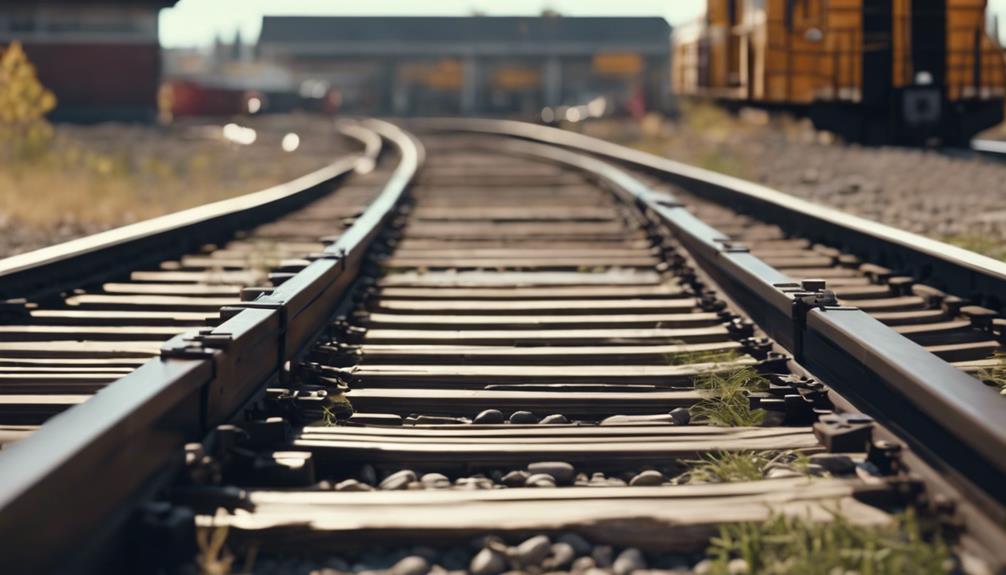How Much Does a Railroad Turnout Cost?

When looking at railroad turnout costs, materials, layout complexity, and maintenance needs shape overall expenses. Factors like switch, frog, and rails influence pricing. The quality of materials, skilled labor, and safety standards impact installation fees significantly. Regular maintenance, proactive repairs, and safety as a priority affect lifespan expenses. Comparing options involves considering initial and long-term costs, emphasizing quality and safety for efficiency. While costs vary, understanding these influences provides insights into the pricing range. Each element contributes to the total expense, guiding your choices for this crucial railway element. Prepare to discover more about railroad turnout costs.
Factors Influencing Railroad Turnout Costs
Understanding the key factors that impact railroad turnout costs is essential for effective budgeting and planning. In ensuring the safety and efficiency of railway operations, various elements play an important role in determining the overall expenses associated with a railroad turnout.
Factors such as the type of materials used, the complexity of the layout, the need for specialized equipment, and the level of maintenance required can significantly influence the total cost of a railroad turnout project.
Components of a Railroad Turnout
A railroad turnout consists of several essential components that facilitate the smooth flow of train traffic along different tracks. These components include the switch, frog, stock rails, closure rails, and guard rails. The switch is a movable rail that guides the train from one track to another, while the frog is where the two rails of the turnout intersect.
Stock rails run along the straight path, leading trains into or out of the turnout, and closure rails are the curved rails that complete the turnout and guide the wheels. Guard rails prevent derailments by keeping the train's wheels aligned correctly on the track.
Each of these components plays an important role in ensuring the safety and efficiency of train operations. Regular maintenance and inspection of these components are essential to prevent accidents and ensure the seamless movement of trains through the turnout. By understanding the function of each component, railway operators can uphold the highest safety standards for train operations.
Installation Expenses for Railroad Turnouts
When considering the installation expenses for railroad turnouts, it's important to factor in the costs of materials and labor involved in setting up these essential components for efficient train operations. Here are some key points to keep in mind:
Prioritizing safety and quality during the installation of railroad turnouts is vital for the smooth functioning of train operations and the protection of passengers and staff.
Maintenance and Lifespan Costs
To effectively manage the costs associated with maintenance and lifespan of railroad turnouts, prioritize regular inspections and proactive repairs. Safety is paramount in maintaining railroad turnouts. By conducting routine inspections, you can catch any potential issues early on before they escalate into more significant problems that could impact safety and operational efficiency. Proactive repairs help extend the lifespan of the turnouts and reduce https://modeltrainenthusiast.com/ the likelihood of unexpected failures.
Regular maintenance activities such as lubricating moving parts, checking for wear and tear, and ensuring proper alignment can help prevent costly repairs down the line. It's essential to follow the maintenance guidelines provided by the manufacturer and adhere to industry best practices to ensure the longevity and best performance of the turnouts.
Investing in quality materials and conducting regular maintenance may require upfront costs but can save you money in the long run by avoiding expensive repairs and ensuring the safety of railway operations. Remember, a well-maintained turnout contributes to the overall safety and efficiency of the railroad system.
Comparing Railroad Turnout Pricing Options
Considering the variety of railroad turnout pricing options available in the market, it's important to assess the Model Trains cost-effectiveness and quality of each to make an informed decision that aligns with your budget and operational needs.
When comparing railroad turnout pricing options, keep the following factors in mind:
Frequently Asked Questions
Can Railroad Turnouts Be Customized for Specific Track Layouts?
Yes, railroad turnouts can be customized for specific track layouts. Ensuring safety and efficiency, these tailored solutions cater to your unique needs. Expert engineers design and implement these turnouts to optimize your railway operations.
Are There Any Environmental Considerations When Installing Turnouts?
When installing turnouts, make sure environmental impact is minimal. Proper disposal of materials, preventing soil erosion, and protecting nearby water sources are crucial. Following regulations and best practices promotes safety and sustainability for all.
How Do Extreme Weather Conditions Impact Turnout Maintenance?
In extreme weather conditions, regularly inspect turnouts for damage and debris. Clear snow, ice, or fallen branches https://modeltrainenthusiast.com/building-a-model-train-table/ promptly to prevent accidents. Guarantee proper drainage to avoid water buildup. Prioritize safety by addressing maintenance promptly.
What Safety Measures Are in Place During Turnout Installation?
When installing a railroad turnout, always prioritize safety. Follow strict protocols, wear appropriate gear, and communicate effectively with your team. Double-check all connections and make certain that warning signs and barriers are in place to protect everyone involved.
Are There Any Regulations Governing the Design of Railroad Turnouts?
You might be surprised, but yes, there are indeed regulations governing the design of railroad turnouts. These rules guarantee safety and efficiency in rail operations. Staying informed about these guidelines is essential for a smooth railway system.